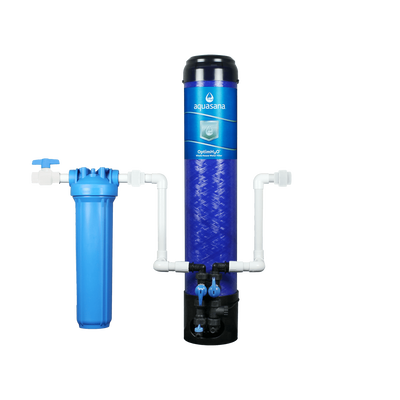In the world of our health, bullies have a lot in common with endocrine-disrupting chemicals (EDCs). Sounds like a stretch, but even after you’ve been away from EDCs, they literally stay beneath your skin, festering and creating more problems long after they’re gone. EDCs disrupt the endocrine system (sometimes by mimicking its processes), making it work against itself.
It’s not just a problem that happens in faraway lands either. EDCs have been found in U.S. cities and well water supplies, too. In a recent study, as many as 38 Organic Wastewater Contaminants (OWCs) — which include EDCs — were found in 111 of the 139 streams sampled.
And the contamination doesn’t stop there. But first, let’s take a step back and look at the important stuff — your body.
What’s My Endocrine System’s Purpose?
The relationship your endocrine system has with your body is a lot like the relationship the sun has with a houseplant. The sun provides light so that the plant can produce food through photosynthesis. But move the plant too far away from the window, or within too much direct light, and the balance of your plant goes completely out of whack.
Our endocrine system works in much the same way. Comprised of the thyroid, pituitary, and adrenal glands — it’s the system that produces and releases hormones for regulating our sleep patterns, biological processes, and our nutrition (i.e. when and why we get hungry).
If your endocrine system goes out of whack, you might experience weight gain or weight loss, insomnia, issues managing stress, or lack the energy you need to perform daily tasks.
Basically, it doesn’t just create the hormones that tell you when to eat, sleep and what moods to feel, it also controls how much is released into your bloodstream, and when, every single day. That’s no small order.
EDCs, according to the Hormone Health Network, are hormone mimics. They are “chemicals or mixtures of chemicals that interfere with the way the body’s hormones work.” And that imbalance can disrupt everything.
What are Endocrine-Disrupting Chemicals?
EDCs are everywhere, aiming to disrupt your whole system. According to the World Health Organization, we come into contact with them through dust, food, water, as well as our personal hygiene products. We can also breathe them in and absorb them into our skin, too.
we come into contact with them through dust, food, water, as well as our personal hygiene products. We can also breathe them in and absorb them into our skin, too.
EDCs are in a ton of products that we use every day, usually in what is referred to as Pharmaceutical and Personal Care Products (PPCPs).
From fragrances to cosmetics, sunscreens to lotions and insect repellants, kids’ toys to building materials, EDCs are there. Even the flame-retardant chemical that our couches are treated with to prevent fires contains EDCs. Basically, if it’s a product that contains or is made from man-made chemicals, there’s a good chance it contains endocrine-disruptors. Sadly, EDCs are in the pharmaceutical medications we take, too. (Doesn’t that sound like another bioaccumulative, man-made contaminant that’s been making the rounds in the news lately?)
Whether you’re aware of them as EDCs or not, you’re likely already well-acquainted with some of the better-known EDCs, despite only just learning that acronym.
Take DDT, for example. Even though DDT has been banned in several countries for a long time, it is still a pesticide that will linger in our environment for decades to come.
Another well-known EDC is Bisphenol-A (BPA) — commonly found in plastic bottles. Perhaps most troublesome, though, are the EDCs in PPCPs, largely because we apply those products directly to our skin.
How EDCs Directly Affect Your Health
The list of conditions that EDCs are suspected of causing reads like a shopping list. The World Health Organization reports that EDCs are thought to “be associated with altered  reproductive function in male and female humans (as well as animals and aquatic life), abnormal growth patterns and neurodevelopmental delays in children, and changes in immune function.” They can even be transferred from a pregnant woman to a fetus, and from mother to child via breast milk. The Hormone Health Network explains other health concerns EDCs have been linked to, including:
reproductive function in male and female humans (as well as animals and aquatic life), abnormal growth patterns and neurodevelopmental delays in children, and changes in immune function.” They can even be transferred from a pregnant woman to a fetus, and from mother to child via breast milk. The Hormone Health Network explains other health concerns EDCs have been linked to, including:
- Breathing problems
- Metabolic issues
- Problems with nervous system function
- Heart health
- Neurobehavioral issues
- Early-onset female puberty
- Obesity
Children are more vulnerable to EDCs than adults, largely because their brains and bodies are still developing, so small amounts of chemicals can have a larger impact.
Of course, the degree to which ordinary consumers should be concerned is unknown. In many instances, the portions of an EDC found in municipal water are in parts-per-trillion, which is very low. But water quality watchdogs are sounding the alarm. In most studies of EDCs’ effects, chemicals have only been studied individually and over a short period of time, or in people who have suffered acute exposure (for instance, if they live somewhere near a chemical waste site that’s leaking into the water).
However, most people are encountering EDCs in small amounts over extended periods of time, there is usually a large combination of EDCs present in the human body, in which case, some EDCs can even combine to form new compounds.
Not only that, but EDCs bioaccumulate. In other words, older people — who’ve had more time to be exposed to small amounts of EDCs over the course of a lifetime — have a higher concentration of EDCs present in their bodies than younger adults.
How EDCs Sneak into our Water
Unfortunately, many EDCs also get into our water and have a bazillion ways of affecting our water quality. Agricultural runoff and spillage from toxic waste sites are certainly players here, but much of the other entry points may surprise you. EDCs go down our drains and into the water supply when we shower, as the runoff from shampoos and soaps contains many EDCs. They also enter waterways when residents flush medications or urinate. In fact, two of the most present EDCs in freshwater are estrogen and progesterone from birth control. Another one? Anabolic steroids. Those are big problems for aquatic life, where those EDCs are interrupting the reproductive functions of fish and other H2O-loving creatures, like the waterfowl.
There’s currently no protocol for removing EDCs from water at city water treatment plants. In fact, many EDCs aren’t even regulated, but studies are underway to develop methods of treating drinking water for them.
Fortunately, many regular water treatment processes have been effective in reducing some EDCs in the water supply. The Water Quality Association points out that “advanced wastewater treatment processes, including ozonation, UV irradiation, photolysis, reverse osmosis, peroxidation (peroxide and UV), and ultrasound can generally achieve higher reduction percentages than conventional treatment.” Additionally, they cite activated carbon as another successful filtering method.
You Don’t Need That Toxicity In Your Life
Pressure your legislators to start regulating the use of chemicals with EDCs, particularly those used in the manufacture of personal products and pharmaceuticals. Try not to purchase over-counter medication, but even when you do, send the leftover meds to a take-back program.
Avoid pesticides by eating organic if you can afford it, particularly fruits and vegetables that are eaten with the peel on (i.e. apples and bananas). Buy personal care products and household cleaners made from natural, organically-grown ingredients. Regardless, wash your fruits and veggies thoroughly before consuming them and use chemical-free filtered water.
Speaking of filtered water, filter out water contaminants with a whole house filtration system, ideally one that’s been NSF certified to Standard 401, which removes EDCs and pharmaceutical, pesticides, and herbicides. Having clean drinking water for ourselves and our families isn’t a treat, it’s a necessity.
